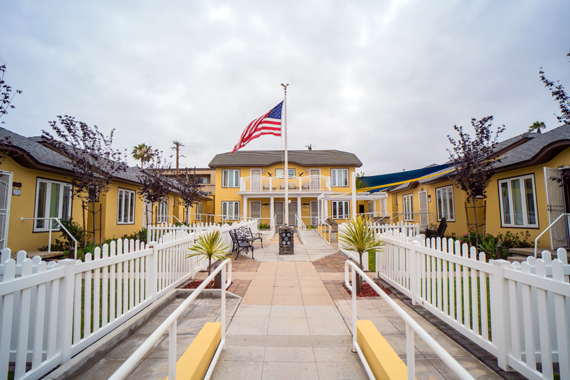|
Affordable Housing Preservation: A Winning Solution
By Bruce Coons
SOHO Executive Director
January/February 2024
 This nine-unit historic bungalow court property is an example of an adaptive reuse, named Freedom Station, it has been highly successful in helping service members transition from military service to civilian life. Photo courtesy warriorfoundation.org
Historic preservation in San Diego can and should become what the San Diego Housing Commission refers to as “affordable housing preservation” by creatively integrating the goals of historical conservation and affordable housing development. This requires a collaborative approach involving local government, developers, community organizations, and residents to find sustainable solutions that benefit both aspects.
Historic preservation in San Diego can play a crucial role in affordable housing preservation through several mechanisms. Here's how:
- Adaptive reuse of historic buildings
- Collaborations between public and private entities
- Simplifying and expediting the permitting and approval processes
- Creating incentives for affordable housing developers
- Establishing community land trusts
- Preserving existing affordable housing stock
Preservation efforts can focus on adapting historic structures into affordable housing units. This involves repurposing old buildings for residential use, which can be a cost-effective way to create affordable housing while maintaining the character and history of the community.
Collaborations between public and private entities can facilitate the preservation of historic structures for affordable housing. Public funding can be directed towards preserving historically significant buildings, and private developers can be encouraged to include affordable housing units in their projects.
San Diego can implement zoning policies that allow for increased density or height bonuses for developers who commit to preserving historic structures and incorporating affordable housing components. This can help balance the competing interests of historical preservation and affordable housing.
Simplifying and expediting the permitting and approval processes for developers engaged in historic preservation and affordable housing projects can reduce costs and encourage more projects in this space.
The city can provide financial incentives, tax credits, or grants to developers who incorporate affordable housing within historically significant areas. This encourages the preservation of historical sites while addressing the need for affordable housing.
Establishing community land trusts for historic properties can ensure long-term affordability. These trusts can acquire and hold title to land, making it more affordable for developers to create and maintain affordable housing within historic districts.
The maintenance and restoration of older affordable housing units contribute to the overall preservation of the community's historic fabric. Preservation of existing affordable housing stock is essential for a healthy community.
Read the San Diego Housing Commission's report Preserving Affordale Housing in the City of San Diego. Note: This report does not contain any historic preservation solutions.
|




